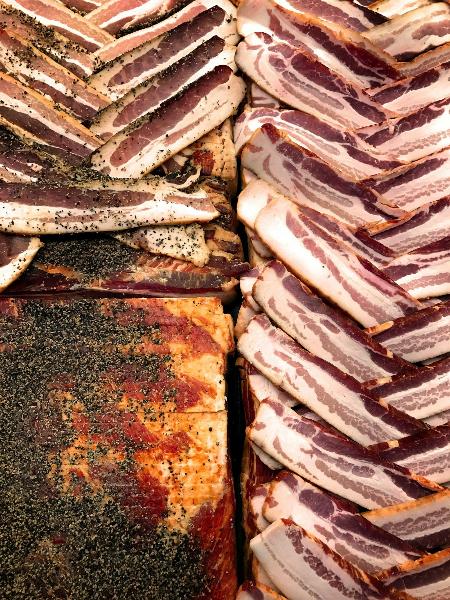Beef Jerky 101: How It’s Made, Why It’s Healthy, and Why It’s Worth Every Bite
Share
Beef jerky has been a cherished snack for centuries, prized for its rich, smoky flavor, high protein content, and impressive shelf life. Whether you pack it in a hunting bag, stash it in the glove compartment, or include it in a lunchbox, beef jerky is a reliable, satisfying treat that fits practically every lifestyle.
At Wisconsin River Meats, we know customers love jerky, but often wonder what really goes into making it and whether it is truly good for you. So let’s break it down:
-
How is beef jerky made?
-
Why is beef jerky healthy?
-
Why is beef jerky worth the price?
Let’s dig into the details of this classic American snack and why it deserves a permanent spot in your pantry.
What Is Beef Jerky, Really?
Beef jerky is a type of dried, cured meat made from lean cuts of beef. The word “jerky” comes from the Quechua word ch’arki, meaning “dried, salted meat,” a method used for centuries to preserve valuable protein without refrigeration.
Today, beef jerky is made by seasoning thin slices of beef, then slowly drying them to remove moisture. The result is a chewy, flavorful, nutrient-rich snack with a distinct smoky aroma.
How Is Beef Jerky Made?
At its core, jerky production is about preserving meat while maximizing flavor. Here’s a look at the traditional process:
1. Selecting the Beef
High-quality jerky starts with a lean cut of beef, such as round or sirloin. These cuts have less fat, which helps prevent spoilage during drying.
2. Trimming and Slicing
Excess fat is trimmed away since fat does not dry well and can go rancid over time. The beef is then sliced thinly, usually around 1/8 to 1/4 inch thick, to ensure even drying.
3. Marinating
The meat slices are marinated in a flavorful blend of salt, spices, and sometimes sugar, honey, or vinegar. This not only boosts flavor but also helps the curing process by adding salt to inhibit bacterial growth.
Popular jerky seasonings include:
-
Black pepper
-
Garlic powder
-
Onion powder
-
Smoked paprika
-
Crushed red pepper
-
Worcestershire or soy sauce
4. Drying and Smoking
Once marinated, the beef is placed on racks and dried in a low-temperature oven or dehydrator. Traditional beef jerky is also smoked, infusing the meat with an unmistakable wood-fired flavor while helping preserve it.
At Wisconsin River Meats, we rely on real hardwood smoke — no shortcuts — to build a complex, authentic taste.
5. Packaging
After drying to the right moisture level, the jerky is vacuum-sealed or packaged in airtight bags with oxygen absorbers to maintain freshness.
Why Is Beef Jerky Healthy?
Many people wonder, Is beef jerky good for you? In moderation, beef jerky is a nutritious, protein-dense snack with several advantages.
High Protein Content
Beef jerky typically delivers around 10–15 grams of protein per serving, making it ideal for athletes, hikers, or anyone needing a satisfying snack that supports muscle health and keeps you full between meals.
Rich in Micronutrients
Because jerky is made from lean red meat, it is naturally rich in iron, zinc, and B vitamins — nutrients that help with energy production, immune support, and healthy blood.
Low in Carbohydrates
Most traditional jerky recipes are very low in carbs, making jerky a great choice for keto, paleo, or low-carb diets.
Portable and Shelf-Stable
Unlike many fresh proteins, jerky does not require refrigeration (before opening), so it’s ready to go whenever you are. That makes it one of the most practical, convenient, high-protein snacks available.
What About Sodium?
One of the only cautions with beef jerky is its sodium content. Because salt is essential to the curing and preservation process, jerky does have a higher sodium level than some other snacks.
If you watch your sodium intake, balance jerky with plenty of fresh fruits and vegetables and low-sodium meals throughout the day. Always check the label — higher-quality jerky brands tend to avoid excess sodium or artificial preservatives.
Why Is Beef Jerky Worth Every Bite (and Every Dollar)?
Some customers wonder why beef jerky costs more than other snacks. It’s a fair question, and here’s why beef jerky is worth it:
Meat Shrinks During Drying
Beef loses about two-thirds of its weight during drying. It takes roughly three pounds of raw beef to make one pound of finished jerky.
Time and Labor
The slicing, marinating, smoking, and drying steps all take time and skill. Unlike chips or candy, jerky is handcrafted in small batches, requiring close attention to food safety and flavor consistency.
Quality Ingredients
Authentic jerky uses whole cuts of beef — not mystery trimmings or byproducts. When you pay for jerky, you’re paying for real, lean beef from trusted sources, plus a traditional spice blend and authentic smoke.
Long Shelf Life
A properly packaged beef jerky snack can last months, making it a smart investment in a convenient, protein-rich food you can count on.
In other words, you get what you pay for — and with beef jerky, you’re buying a product made with care, quality meat, and time-honored craftsmanship.
How to Enjoy Beef Jerky
Jerky is more than just a quick road trip snack. Here are some creative ways to enjoy it:
-
Chop it into small pieces and sprinkle over a salad for extra protein
-
Pair with cheese and whole grain crackers for a balanced snack
-
Mix with nuts and dried fruit for a custom trail mix
-
Add to ramen or instant soup for a smoky, savory boost
-
Tuck jerky into kids’ lunchboxes as a satisfying protein source
Jerky’s versatility and rich flavor make it one of the easiest, most practical snack foods to keep on hand.
How to Store Beef Jerky
Unopened packages of vacuum-sealed jerky are shelf-stable and should be kept in a cool, dry place. Once opened, store jerky in a sealed bag or airtight container in the refrigerator, and enjoy it within 5–7 days for the best flavor and freshness.
For longer storage, you can freeze jerky in an airtight freezer-safe bag, then thaw as needed.
Frequently Asked Questions
How long does beef jerky last?
Unopened, vacuum-sealed jerky can last several months. Once opened, refrigerate and eat within a week.
Is homemade jerky safe?
Yes, as long as you use proper food safety methods, including using a meat thermometer to confirm safe temperatures during drying, and curing with appropriate salt levels.
Can kids eat beef jerky?
Absolutely. Jerky is a healthy snack for kids, but watch portion sizes and be mindful of the sodium content.
Is there sugar in beef jerky?
Some jerky recipes add a touch of sugar or honey for flavor. If you’re concerned, read the label or choose unsweetened varieties.
Final Thoughts
Beef jerky is more than just a snack — it is a symbol of traditional food preservation, a link to centuries-old methods of curing and drying meat, and a delicious, high-protein option that supports an active lifestyle.
Whether you are hitting the trail, packing a lunch, or just craving a protein-rich bite between meals, beef jerky delivers flavor, convenience, and nutrition in a single package.
At Wisconsin River Meats, we are proud to make small-batch beef jerky the traditional way, using premium cuts of beef, natural spices, and authentic hardwood smoke. That means no shortcuts, no fillers, and no compromises — just rich, smoky goodness you can trust.
If you’re ready to experience real beef jerky done right, explore our beef jerky selection or stop by our Mauston shop. We’d be happy to help you discover your favorite flavor, whether you prefer peppered, sweet, teriyaki, or classic smoked.
Beef jerky is worth every bite — and every dollar — when it’s made with skill, respect, and tradition.

